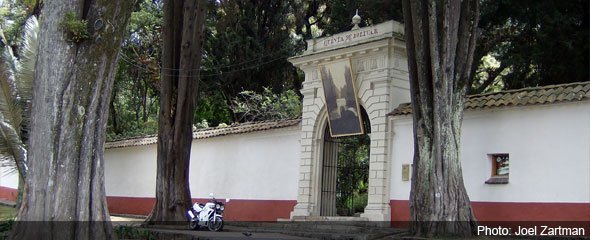
Near the center of Bogotá is a winding way called Las Aguas; it contains a series of descending pools of water, broad sidewalks, palms and willows. The walk is actually a longish one, with pigeons bathing in the water, bums washing in the water, and usually lots of students heading up toward the U of the Andes, one of the most prestigious universities in Bogotá.
Past the U and up the side of the hill a little further—on your way to Monserrate—you come to the house of Simón Bolívar–La Quinta Bolívar. It is a pleasant place with old trees—some massive, ancient pines—gardens, walks, the house and buildings, and even a collection of elegant canons from back in the time when Bolívar found them handy.
Bolívar is the liberator of the Gran Colombia, which comprises Colombia, Venezuela, Peru, Equador, Bolivia and also Panama. No other person is more venerated in Colombian history, and none has more statues erected than does Don Simón. He was a romantic in the style of Russeau, controversial, headstrong and from time to time a bit impractical. Near the end of his life he escaped—with the aid of his girlfriend, a married woman from Quito and a scandal in Santa Fe de Bogotá—by leaping out of a window (the window is located in another building—el palacio de San Carlos, and is marked with a Latin inscription) and making his way, dying of tuberculosis, to the coast. He gave up the ghost in Santa Marta. He owned this house—La Quinta Bolívar—in Bogotá having received it from the government in thanks for liberating them, and occupied it during for some time, but also had the aforementioned presidential palace to inhabit, from time to time.
The house is damp, of course, and curiously devoid of fireplaces or braziers. There is one room with a fireplace, but that’s all. Actually, the place itself is not as big as one would expect. Bolívar was aristocratic, a european in many ways—as the furniture, ornaments and china show—proud, and enormously important. But his house, though large enough, is no mansion.
In the whole place there were only two bedrooms: one belonged to Bolívar and the other one belonged to his faithful servant. Where the others slept is a bit of a mystery. The house itself has five drawing rooms, variously designated, a large dining room, and then outbuildings for kichens, stables, and such. All of it is furnished, labeled, guarded, and a very nice museum. You can’t even tell that it had been used as a brewery in days past.
What makes it a pleasant place are the grounds with large gardens, the wide porch running all the way around and the sense of a quiet country home. It has an elaborate drainage system running through the whole and this shows perhaps why people built the cities on the sides of the hills with steep streets and all. By building on the hill the channels running all through the Quinta irrigate the gardens, water the stables and channel the dirty dishwater out of the kitchen. All of it natrually flows downhill and away. With the frequent rains in Bogotá, it must have kept the place ideally clean, and one can’t help thinking the whole thing was ingenious. More country houses ough to have channels running through the grounds so that the pleasant sounds of running water may always, everywhere be heard.

